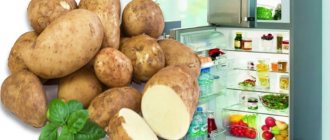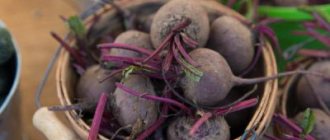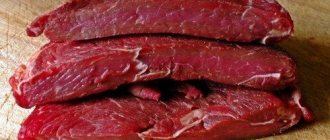Hi all! Onions are already considered a traditional product of Russian cuisine: they are added to almost all dishes to improve the taste. It’s not enough to just grow it, you also need to preserve it.
Proper storage requires mandatory drying and choosing a place for the vegetable where it can survive the winter and not rot. After the onions have been removed from the garden, it is equally important to dry them and choose a suitable container for storage.
By the end of summer, gardeners begin to harvest, which means that at this time it is necessary to prepare a place for storing this crop.
Is it allowed and how much?
Onions in the kitchen can be at room temperature and low humidity , but such conditions are favorable for germination.
The temperature in the refrigerator is on average from +1°C to +3°C. This is the optimal indicator for storage, allowing you to keep onions without sprouting, and even keep them in a peeled state.
But there are also some disadvantages to using a refrigerator as a storage area for vegetables:
- short shelf life;
- it will not be possible to place large volumes;
- If storage is carried out without packaging, then the specific smell will permeate all the products.
In the vegetable compartment, onions are best preserved wrapped in a bag or placed in a plastic container.
The need to put onions in the refrigerator may arise when, after preparing a dish, there is excess product left, in some cases even already peeled and chopped.
If you properly package and store whole onions, they can last 30-60 days in the refrigerator.
You will find a lot of useful and important information about storing onions here.
Medicinal properties of onions
Onion is a medicine that helps with many diseases:
- The high percentage of iron in onions allows it to be used to treat anemia; mineral salts regulate the water-salt balance. Eating a small amount of onion increases appetite and strengthens the immune system.
- It is used as a protective or therapeutic agent for colds. The essential substances that make up onions fight germs, viruses and bacteria. Sulfur relaxes the muscles of the respiratory tract, preventing the formation of phlegm and asthma attacks.
- Onion juice mixed with warm water relieves swelling in the throat and fights cough. It disinfects the oral cavity, preventing the formation of caries and gum inflammation.
- Onions lower blood cholesterol levels, lower blood pressure, and prevent heart attacks. It prevents the formation of blood clots, which is why it is used to treat thrombophlebitis. It is used as a diuretic.
- Fructooligosaccharides, which are found in onions, help reduce the risk of cancer in the rectum.
- Onion juice is used to treat ear diseases. But you need to be careful not to damage the delicate tissues of the middle ear. Dilute the juice with warm water.
- Chopped onions are used to remove warts and calluses. Manifestations of dermatitis may disappear if you lubricate them with onion juice.
- Onions are used to treat diabetes. Chromium and its antioxidants reduce sugar levels and increase insulin production. Onions are used in various diets for weight loss. It is included in dishes and not used separately. The juice has an aggressive effect on the stomach.
- Folic acid helps relieve depression. Its consumption causes the production of serotonin, which is called the hormone of happiness.
People with stomach ulcers and other diseases of the gastrointestinal tract, liver, and kidneys should not consume raw onions in large quantities.
Onions are used in cosmetology. Its juice is used to treat baldness, seborrhea, and hair loss. For treatment, rub onion juice into the hair roots. A face mask removes wrinkles, age spots and freckles.
Preparing to store onions
Onions can be stored in the refrigerator in several ways, taking into account the condition of the product, its type and the volume occupied. Vegetables that were collected on time and dried well are preserved better than others.
During the harvesting process, the roots should not be damaged, nor the bulbs themselves. It is most convenient to dry the onions in the open air, avoiding exposure to sunlight. Another option is to tie it and hang it in bunches.
After drying, the vegetable should be completely dry, including the top . Otherwise, the vegetable will not be able to be stored for long.
Immediately before storing, the entire volume of vegetables is sorted out, discarding damaged ones. Dried tops and roots are trimmed.
Read about storing onions in a cellar or basement here, at home in winter - here.
When to harvest
How well the onions will be stored primarily depends on the right moment for harvesting.
It is believed that the optimal time for digging onions is from early August to early September. Naturally, the exact period depends on the climatic conditions of the region and whether the summer was dry or rainy. It is not difficult to determine whether a vegetable is ripe: its husk will easily come away from the bulb, and the feathers will dry out and turn yellow.
It is necessary to harvest on a dry day so that rain does not damage the plant. Try to select for long-term storage those specimens that do not have any damage, stains or traces of insects on their surface.
The vegetable must be ripe, otherwise it will quickly deteriorate during storage. An overripe plant should not be used for long-term storage: it begins to sprout roots and new green shoots within a month or two, which means it will become unsuitable for cooking.
Experienced gardeners know that late-ripening varieties are best stored. And early and sweet ones, such as the Yalta variety, are not very suitable for storing for the winter.
The new crop should be stored in a dry and cool place, away from direct sunlight. If the humidity is too high, the bulbs will quickly begin to rot.
You can also grow this plant for the next season using nigella - onion seeds. They are black in color, which is why they got their name. It is necessary to wait until the plant is completely ripe, and then cut off the inflorescences and leave them to dry. It is better to store arrows with seeds in a dry place: this way they will be easily separated.
Read more about methods of growing onions in our article.
All possible options
The duration of its storage in the refrigerator and the necessary packaging largely depend on the form in which the onions are sent for storage.
Crude
Unpeeled prepared onions can be placed in the vegetable compartment in the refrigerator. An egg container is suitable as a container . Each bulb will be located separately in it.
Another option is paper bags. They should not be tightly closed to prevent condensation from forming inside. Under such conditions, storage duration can be up to 2 months.
Purified
If there are already peeled onions left after cooking, you can store them in the refrigerator. For this:
- The vegetable is washed.
- Place in a glass jar or plastic container.
- Add cold water.
- Change the water every couple of days.
The maximum storage period under such conditions is up to 20 days. More information about ways to store peeled onions can be found here.
Cut
Peeled and chopped onions are more difficult to preserve than whole ones. There are several ways to cope with the problem.
If half or a segment is cut off from the bulb, then the following options will help:
- The cut is greased with sunflower oil and placed on this side in a container. It is better to cover the top with a lid. Without a lid, the storage time is a day, with a lid – several days.
- The remaining part of the onion is wrapped in film. The product can be stored in this form for no more than 4-5 days.
- A layer of salt is poured into the container. Place the onion on it, cut side down. Storage - no more than a week.
Finely chopped onions are not stored for long - up to 12 hours in a container. It is best to use it for food or process it for long-term storage - freeze, dry, etc.
Fried
Fried vegetables can be stored for a long time only in one case - when they are frozen :
- The vegetable is cut.
- Fry in vegetable oil.
- Cool.
- Place in containers or plastic bags.
- Place in the freezer.
When using such a preparation, you don’t have to defrost it in advance, but immediately add it to the dish you are preparing, for example, soup.
Marinated
Pickled onions are an original addition to salads, cooked potatoes, pork and other dishes.
Due to its versatility, pickling onions is a good way not only to preserve vegetables, but also to make a very tasty preparation for many dishes. It can be used gradually as needed.
Procedure:
- Wash and peel the onions (3 pcs.).
Cut into half rings.- Mix the ingredients for the marinade in a bowl (sugar - 3 tbsp, salt - ½ tbsp, vinegar - 7 tbsp, boiled water - 0.25 l).
- Stir the marinade until the salt and sugar are completely dissolved.
- Place onions in a glass jar.
- Pour over the marinade.
- Place in the refrigerator.
After just ½ hour the product can be ready for use. Lightly frying it before serving will add additional originality to the dish. The pickled product can be stored for up to six months.
This video will show you how to pickle onions for the winter:
Types of onions
Several types of onions are used in cooking. Basic:
- Bulb onions
- shallot
- Leek
- Batun
- Schnitt
- Slime
From these species, onions and shallots form bulbs that are eaten. Shallot has the popular names kushchevka (Ukraine), family (Russia, Moldova). Therefore they have similar properties. Shallots can be stored longer without sprouting. It can withstand lower temperatures more easily.
In other species, leaves (feathers) are more often used. They grow in bushes. Schnitt and slime are often used as ornamental plants. Many gardeners do not even know that the leaves of these flowers can be eaten.
Leeks are more similar in appearance to garlic; they have large, flat leaves folded along the vein.
Onions contain vitamins B, C, E. minerals sodium, magnesium, potassium, calcium, phosphorus, iron, zinc, fluorine, manganese. 100 g of onion contains 88 g of water, 11 g of carbohydrates, proteins, pectins, folic acid, antioxidants. Calorie content of 100 g of onion is 43 kcal.
Onions are used raw as a seasoning for vegetables and added to first and second courses. Onions do not lose their taste and energy values during heat treatment. Therefore, it is fried along with other vegetables, meat, fish, and mushrooms.
Rules for freezing vegetables
Vegetables can be frozen in various ways:
- entirely;
- sliced;
- already cooked.
The best option is to cut the vegetable in advance before freezing. This will allow:
- ensure compact storage;
- defrost in the future as much product as needed at one time.
It is convenient when frozen vegetables are packaged in portions. This will allow you to easily separate as much product as needed without using force or breaking off the solid caked frozen piece.
Procedure:
- Wash and peel the onion.
- Chop finely.
- Place immediately into small containers, or, alternatively, freeze in one layer in a wide flat container, and then pour into a bag or container.
A properly frozen vegetable can be stored in the freezer until the next harvest. During storage, a significant part of the nutrients is retained.
The main requirement is not to re-freeze the thawed onion . And do not allow even partial defrosting of the workpiece, which must lie for a long time.
How to freeze onions for the winter, video recipe:
Storing green onions
Green onions are more difficult to preserve than onions. Greens are more demanding on maintenance conditions and can quickly disappear.
in the refrigerator :
- in kraft paper – up to 3 weeks;
- in a cellophane bag – up to 1.5 months;
- in glass containers – no more than a month;
- with a damp cloth in cellophane - up to a month.
When sending green onions for storage, you must ensure that the leaves do not wrinkle or bend, as this will accelerate wilting.
You can learn about storing green onions in the refrigerator here, and ways to preserve them for the winter here.
How can you store onions in a cellar or basement for a long time?
Residents of private houses can store onions in underground storage facilities, but only if they are dry and equipped with an exhaust hood. A damp cellar is not suitable for storing these vegetables - in a cold, damp place the vegetable may begin to rot. The temperature in the cellar should not rise above 0-3°C, humidity - above 60-70%.
You can put the bulbs in wooden or plastic boxes, nets, baskets. There is no need to fill the container to the top; you should leave room for air circulation. For the same reason, it is not recommended to place boxes or stack nets on the storage floor; it is better to place them on racks or wooden pallets.
If there are not many onions and there is enough space in the cellar, you can simply lay them out on the shelves in a thin layer.
To disinfect onions, you can sprinkle them with crushed chalk or ash (200 g for every 10 kg of vegetables), and to reduce humidity, place containers with lime or small shavings in the cellar, or scatter them on the floor. The accumulated husks should also not be thrown away - they protect the vegetable well from waterlogging.
Whatever method of storing onions you choose, regularly (at least once a month) review and sort through the vegetable in order to promptly detect rotten, sprouted, soft or shriveled ones.
Remove and throw them away without hesitation, otherwise the rest of the onion will suffer. However, sprouted bulbs, if they are hard enough, can be used for forcing greens.
The damp but intact vegetable and the container in which it was lying must be dried again, the cellar ventilated, then the vegetables must be returned to their place. If everything is done correctly, the onion will last until spring, and some particularly successful specimens will last until summer.
Leek
A small amount of leek can be stored in the refrigerator. The compartment intended for vegetables is best suited for this.
When placed in it , excess leaves are cut off and distributed into polyethylene bags of 6-8 pieces per bag . Cellophane allows you to maintain the required level of humidity. Temperature suitable for storage is up to +5°C.
If you are interested in how to store leeks in a cellar or basement, read this article. Read about ways to store leeks in winter here.
Prepare the container
The vegetable must “breathe” in it, that is, have access to fresh air.
Onions should not be kept in plastic bags because they do not allow air to pass through.
Wicker baskets, nylon stockings or tights, special nets, wooden boxes or cardboard boxes with ventilation holes on the sides are well suited for storage. Fabric bags are also suitable, just keep in mind that the height of onion stocks should not exceed 30 centimeters - otherwise the bottom layer will “suffocate”.











